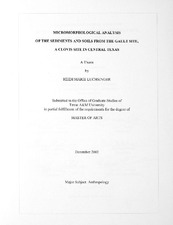| dc.creator | Luchsinger, Heidi Marie | |
| dc.date.accessioned | 2012-06-07T15:47:20Z | |
| dc.date.available | 2012-06-07T15:47:20Z | |
| dc.date.created | 2002 | |
| dc.date.issued | 2002 | |
| dc.identifier.uri | https://hdl.handle.net/1969.1/ETD-TAMU-2002-THESIS-L82 | |
| dc.description | Due to the character of the original source materials and the nature of batch digitization, quality control issues may be present in this document. Please report any quality issues you encounter to digital@library.tamu.edu, referencing the URI of the item. | en |
| dc.description | Includes bibliographical references (leaves 109-116). | en |
| dc.description | Issued also on microfiche from Lange Micrographics. | en |
| dc.description.abstract | The Gault site is a Paleoindian site (ca. 11,500-8500 BP) in Central Texas that contains an unusual abundance of cultural material for this period. Due to the importance of this site for Paleoindian archaeology, a broad-scale geoarchaeological investigation was undertaken in order to construct a stratigraphic and temporal framework and reconstruct site formation processes and paleoenvironmental history. Micromorphological analysis was incorporated into this geoarchaeological study to clarify several issues that were not readily understood during excavation. This micromorphological study had four research objectives: 1) evaluation of the origin of calcium carbonate nodules found throughout the site to give indication of the extent of pedogenesis; 2) assessment of the impact of groundwater on each stratigraphic unit; 3) evaluation of additional post-depositional processes including bioturbation to determine integrity of the site; and 4) search for evidence of occupation surfaces on the microscale that were not visible during excavation. Results based on micromorphological and soil characterization analyses indicate that calcium carbonate nodules at this site are mostly pedogenic although some carbonates were inherited from alluvial or colluvial sources. In addition, groundwater had a significant impact on sediments and the preservation of organic materials due to an aquitard present in Unit 3a that perched the water table into overlying sediments causing groundwater to flow laterally during periods of high discharge and seep upwards during periods of low discharge. Bioturbation by small organisms such as earthworms and ants was evident in all stratigraphic units. It is likely that bioturbation caused the destruction of discrete occupation surfaces, clear stratigraphic breaks, and prehistoric organic remains. Finally, this analysis was able to offer insights for reconstructing the paleoenvironment of the Gault site, and may suggest the presence of a Clovis-Age drought. | en |
| dc.format.medium | electronic | en |
| dc.format.mimetype | application/pdf | |
| dc.language.iso | en_US | |
| dc.publisher | Texas A&M University | |
| dc.rights | This thesis was part of a retrospective digitization project authorized by the Texas A&M University Libraries in 2008. Copyright remains vested with the author(s). It is the user's responsibility to secure permission from the copyright holder(s) for re-use of the work beyond the provision of Fair Use. | en |
| dc.subject | anthropology. | en |
| dc.subject | Major anthropology. | en |
| dc.title | Micromorphological analysis of the sediments and soils from the Gault site: a Clovis site in Central Texas | en |
| dc.type | Thesis | en |
| thesis.degree.discipline | anthropology | en |
| thesis.degree.name | M.A. | en |
| thesis.degree.level | Masters | en |
| dc.type.genre | thesis | en |
| dc.type.material | text | en |
| dc.format.digitalOrigin | reformatted digital | en |


